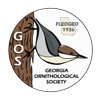GOS Fall Meeting
Jekyll Island, Georgia
October 5-8, 2018
Keynote Speaker – Denver Holt - Owl Research Institute
GOS Friday Speaker – Tim Keyes, Abby Sterling, Brad Winn - Manomet Observatory
Bird List Compiled by Ellen Miller - 153 species
Temperatures were much warmer a little more than a month ago when we gathered on Jekyll Island for the fall meeting. They were approaching 90˚F and, of course, the humidity was very high, too. I was fortunate to have attended the field trip to Altama Plantation Wildlife Management Area, one of the newer acquisitions of the Georgia Department of Natural Resources (GA DNR). We all were delighted to have very good looks at an incredibly cooperative Black-billed Cuckoo. The photographers among us were able to document the rarity as it consumed a few caterpillars before we lost track of it. For many on the trip, including me, it was our first Black-billed Cuckoo. I heard great reports from other field trips conducted during the long weekend. Many thanks to the field trip leaders: Adam Betuel, Diana Churchill, Nathan Farnau, Malcolm Hodges, Gene Keferl, Tim Keyes, Bill Lotz, Evan Pittman, Bob Sattelmeyer, John Mark Simmons, Andrew Theus, Lydia Thompson, Dan Vickers, and Gene Wilkinson. Thanks also to First Vice President Ellen Miller for coordinating the field trips and recruiting speakers and to Second Vice President Ed Maioriello for securing our venue and coordinating our “Flockings” and banquet.
The Friday night presentation was delivered by Tim Keyes (GA DNR), Abby Sterling (Manomet Observatory), and Brad Winn (Manomet Observatory and formerly GA DNR). Their talk centered on the criticality of conserving Georgia coastal habitats as breeding grounds, wintering grounds, and migration stopover habitat for large numbers of shorebirds. The uniqueness of the Georgia coast is highlighted by the fact that the Western Hemisphere Shorebird Reserve Network (WHSRN) recently designated our coast as a “Landscape of Hemispheric Importance.” Georgia’s coast was the 100th site recognized for its importance to shorebird migration, but it is only the third to have been designated at the “landscape” scale. The trio also discussed the importance of the entire Georgia Bight, which includes coastal South Carolina, Georgia, and northeastern Florida, and their involvement with the Georgia Bight Shorebird Conservation Initiative. Thanks to Tim, Abby, and Brad for their informative talk and their dedication to the conservation of Georgia’s shorebirds.
Our keynote speaker was Denver Holt, founder of the Owl Research Institute (ORI). Denver’s talk was animated, humorous, and informative. If you were at the meeting, you also know that he is quite an accomplished mimic of many owl species. The first part of Denver’s talk was a who’s who (pun intended) of North American owl species, their evolution and relationships, and their great ability to hide themselves via their cryptic plumage. Denver also spoke about ORI’s long-term Snowy Owl/lemming research in Alaska, about to enter its 27th year of study. We have long known that Snowy Owl populations wax and wane depending on the cyclical nature of lemming abundance, but Snowy Owl populations have declined 64% since 1970, a trend that is not fully explained by the availability of prey items. Denver believes that warming climates may be partially responsible and has documented thinner ice, deeper permafrost, and less snow accumulation during the course of his study. He hopes that his continuing research will help identify the main causes of Snowy Owl declines and, hopefully, provide a path forward to implement remedies to conserve this wonderful species.
Bird List:
Black-bellied Whistling Duck
Canada Goose
Wood Duck
Mallard
Mottled Duck
Blue-winged Teal
Northern Shoveler
Pied-billed Grebe
American White Pelican
Brown Pelican
Double-crested Cormorant
Anhinga
Great Blue Heron
Great Egret
Snowy Egret
Little Blue Heron
Tricolored Heron
Reddish Egret
Cattle Egret
Green Heron
Black-crowned Night-Heron
Yellow-crowned Night-Heron
White Ibis
Glossy Ibis
Roseate Spoonbill
Wood Stork
Black Vulture
Turkey Vulture
Osprey
Bald Eagle
Northern Harrier
Cooper’s Hawk
Red-shouldered Hawk
Red-tailed Hawk
American Kestrel
Merlin
Peregrine Falcon
Clapper Rail
King Rail
Sora
Common Gallinule
American Coot
Black-bellied Plover
Wilson’s Plover
Semipalmated Plover
Piping Plover
Killdeer
American Oystercatcher
American Avocet
Spotted Sandpiper
Greater Yellowlegs
Willet
Lesser Yellowlegs
Long-billed Curlew
Marbled Godwit
Ruddy Turnstone
Red Knot
Sanderling
Semipalmated Sandpiper
Western Sandpiper
Least Sandpiper
White-rumped Sandpiper
Pectoral Sandpiper
Dunlin
Stilt Sandpiper
Short-billed Dowitcher
Long-billed Dowitcher
Laughing Gull
Ring-billed Gull
Herring Gull
Great Black-backed Gull
Caspian Tern
Forster's Tern
Royal Tern
Sandwich Tern
Black Skimmer
Rock Pigeon
Eurasian Collared-dove
Mourning Dove
Yellow-billed Cuckoo
Black-billed Cuckoo
Eastern Screech-owl
Great Horned Owl
Chimney Swift
Ruby-throated Hummingbird
Belted Kingfisher
Red-headed Woodpecker
Red-bellied Woodpecker
Downy Woodpecker
Red-cockaded Woodpecker
Northern Flicker
Pileated Woodpecker
Eastern Wood-pewee
Eastern Phoebe
Great Crested Flycatcher
Loggerhead Shrike
White-eyed Vireo
Yellow-throated Vireo
Red-eyed Vireo
Blue Jay
American Crow
Fish Crow
Tree Swallow
Northern Rough-winged Swallow
Barn Swallow
Carolina Chickadee
Tufted Titmouse
White-breasted Nuthatch
Carolina Wren
House Wren
Marsh Wren
Blue-gray Gnatcatcher
Eastern Bluebird
Swainson’s Thrush
Gray Catbird
Northern Mockingbird
Brown Thrasher
European Starling
Tennessee Warbler
Nashville Warbler
Northern Parula
Yellow Warbler
Chestnut-sided Warbler
Magnolia Warbler
Black-throated Blue Warbler
Blackburnian Warbler
Yellow-throated Warbler
Pine Warbler
Prairie Warbler
Palm Warbler
Black-and-white Warbler
American Redstart
Prothonotary Warbler
Worm-eating Warbler
Northern Waterthrush
Common Yellowthroat
Eastern Towhee
Savannah Sparrow
Seaside Sparrow
Summer Tanager
Scarlet Tanager
Northern Cardinal
Rose-breasted Grosbeak
Blue Grosbeak
Indigo Bunting
Painted Bunting





